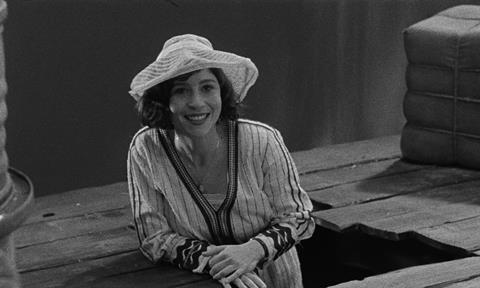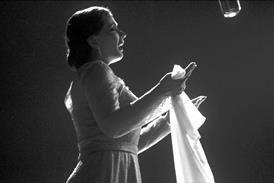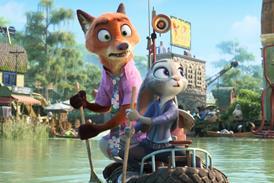Miguel Gomes transposes the traditional European grand tour narrative to Asia for his experimental Competition entry

Dir. Miguel Gomes. Portugal/Italy/France 2024. 129mins
The traditional Western gaze of travellers’ tales is refracted through the lens of experimentation in Grand Tour, a hypnotic and inventive Asian odyssey from Portuguese filmmaker Miguel Gomes. All Gomes’ films, including Tabu and his epic trilogy The Arabian Nights, are informed by a political curiosity about the world and by a desire to test storytelling forms. In Grand Tour, he plays with time and geography, mixing modern documentary footage with echoes of mid-twentieth-century Hollywood and the Westerners-abroad fictions of writers like Joseph Conrad and Somerset Maugham.
A hypnotically inventive Asian odyssey
The viewer may not know exactly where Gomes and his characters are headed, but the journey is pursued with wit, imagination and intelligence, and delivers oblique insights about the way we see the world and history. Grand Tour is every bit as niche as previous Gomes outings, and can expect the same enthusiastic support from those who respond to his work.
At one point, a character is described as “delirious but serene”. The same could be said for the film, shot in multiple Asian countries (China, Japan, the Philippines, Vietnam…) and on European studio sets, with its narrative cooked up by a ‘central committee’ (as the credits put it) of writers including Maureen Fazendeiro, Gomes’s directing collaborator on 2021 lockdown film The Tsugua Diaries. With three DPs including Apichatpong and Guadagnino collaborator Sayombhu Mukhdeeprom, Grand Tour mixes documentary footage shot in a range of Asian locales with a diptych of stories about a Western couple in 1917.
Its first half follows a pipe-smoking, linen-suited Englishman named Edward Abbot (Gonçalo Waddington), who is supposed to meet his fiancée Molly Singleton (Crista Alfaiate) after a seven-year separation. Instead he takes fright, and goes on a long journey to avoid her, from Myanmar (then Burma) to Saigon, Manila, Osaka, Shanghai and the outskirts of Tibet, meeting various pointedly generic characters along the way. They include Molly’s lowlife cousin, encountered at the Raffles Hotel: like Edward, he’s straight out of English colonial-era yarns, but the joke is that these frightfully familiar pillars of Empire, who know the Eton Boating Song by heart, speak in Portuguese throughout.
After following Edward’s encounters, the film switches to Molly, who has been doggedly pursuing her man all this time. Gomes now revisits the same locations and same footage through a different perspective, as we follow the far more likeable Molly – a resilient character with a radiant smile and a ripe laugh. En route, she is courted by an American cattle baron (Cláudio da Silva) but takes off with his housekeeper Ngoc (Lang Khê Tran) on what will be a darker stretch of the journey .
Grand Tour is one of those films that repeatedly has the viewer wondering where it is going – and as it proceeds, it feels as if it is constantly asking itself the same question, making for a bracing experience of discovery in real time. Not that time is remotely real in any usual sense: not only does Gomes work plentiful anachronism into the 1918 story (not least musical), but the film zigzags between semi-realistic period recreations and the documentary footage very markedly showing the Asian locations as they are today. The material is edited in a way that paradoxically meshes them into a coherent whole, yet also declares that the mesh is anything but seamless.
The accent on discrepancy runs to the combinations of music and image (a Shanghai martial arts performance to the sound of a cheesy hotel band from the previous sequence) and the disconnect between languages. Then there is the gulf between the present-day Asia, which will seem familiar to any viewers of contemporary cinema from China or the Philippines, and the idea of an exotic, infinitely distant ‘East’, located in a permanent ‘magical’ past, evoked by the 30s/40s Hollywood cinema pastiched here.
The visuals are transfixing, whether it’s the studio sequences (pastiche shades of von Sternberg et al), photographed by Tabu DoP Rui Pocas, or the vast sweep of urban and natural imagery mixing colour and black and white, sometimes superimposed. And the film is narrated throughout from a variety of Asian viewpoints, by male and female voice-overs in the languages of each location – Gomes pointedly refuses to provide subtitles for the Chinese, Vietnamese, Japanese and other dialogues heard throughout, inverting the rules of colonial narrative in which the Western ear and eye have access to all meaning.
Production company: Uma Pedra no Sapato
International sales: Match Factory sales@matchfactory.de
Producer: Filipa Reis
Screenplay: Mariana Ricardo, Telmo Churro, Maureen Fazendeiro, Miguel Gomes
Cinematography: Rui Pocas, Sayombhu Mukhdeeprom, Guo Liang
Production design: Thales Junqueira, Marcos Pedroso
Editors: Telmo Churro, Pedro Felipe Marques
Main cast: Crista Alfaiate, Gonçalo Waddington, Cláudio da Silva, Lang Khê Tran
























